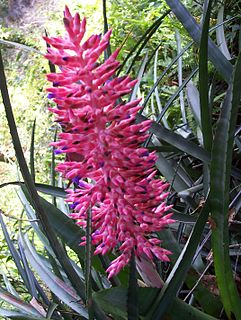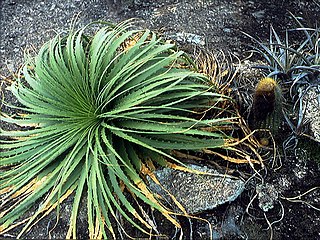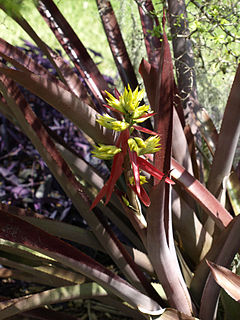
The Bromeliaceae is a family of monocot flowering plants of 75 genera and around 3590 known species native mainly to the tropical Americas, with several species found in the American subtropics and one in tropical west Africa, Pitcairnia feliciana.

Araeococcus is a genus of the botanical family Bromeliaceae, subfamily Bromelioideae. It is native to northern South America, Central America and Trinidad.

Cryptanthus is a genus of flowering plants in the family Bromeliaceae, subfamily Bromelioideae. The genus name is from the Greek cryptos (hidden) and anthos (flower). The genus formerly had two recognized subgenera: the type subgenus and subgenus HoplocryptanthusMez which has been raised to the separate genus Hoplocryptanthus. All species of this genus are endemic to Brazil. The common name for any Cryptanthus is "Earth star".

Aechmea distichantha, the Brazilian vaseplant, or vase plant, is a bromeliad typical of Cerrado vegetation in Brazil, which is also native to northern Argentina, Bolivia, Paraguay, and Uruguay. This plant is often used as an ornamental plant.

Encholirium is a genus of plants in the family Bromeliaceae, subfamily Pitcairnioideae. The entire genus is endemic to Brazil. The genus name is from the Greek “enchos” (spear) and “leiron” (lily).

Hohenbergia stellata is a perennial species of the genus Hohenbergia. It is native to Trinidad and Tobago, Martinique, Netherlands Antilles, Venezuela, and northeastern Brazil.

Dyckia leptostachya is a plant species in the genus Dyckia. This species is native to Brazil, Bolivia, Paraguay, and Argentina.
Aechmea alba is a species of plant in the genus Aechmea. This species is endemic to Brazil.

Aechmea emmerichiae is a [species]] of flowering plant in the genus Aechmea. This species is endemic to Chapada Diamantina National Park in eastern Brazil.

Wittmackia patentissima is a species of plant in the family Bromeliaceae. This species is endemic to Brazil.

Aechmea purpureorosea is a plant species in the genus Aechmea. This species is endemic to southeastern Brazil, States of Minas Gerais and Rio de Janeiro.
Pseudaraeococcus chlorocarpus is a species of flowering plant in the family Bromeliaceae, native to Brazil. It was first described in 1862 as Lamprococcus chlorocarpus.
Pseudaraeococcus montanus is a species of flowering plant in the family Bromeliaceae, endemic to Brazil. It was first described in 1999 as Araeococcus montanus.
Pseudaraeococcus nigropurpureus is a species of flowering plant in the family Bromeliaceae, endemic to Brazil. It was first described in 2007 as Araeococcus nigropurpureus.
Pseudaraeococcus sessiliflorus is a species of flowering plant in the family Bromeliaceae, endemic to Brazil. It was first described in 2007 as Araeococcus sessiliflorus.
Billbergia elegans is a plant species in the genus Billbergia. This species is native to Brazil.

Tillandsia geminiflora is a species in the genus Tillandsia. This species is native to Brazil, Suriname, Paraguay, Uruguay, and the Misiones Province of Argentina.

Aechmea lingulata is a plant species in the genus Aechmea. This species is native to the West Indies, Costa Rica, Panama and northern South America.

Pitcairnia caricifolia, synonym Pepinia caricifolia, is a species in the genus Pepinia. This species is native to tropical South America.
Pseudaraeococcus is a genus of flowering plant in the family Bromeliaceae, native to northeastern Brazil. It was first described as the subgenus Pseudaraeococcus of the genus Araeococcus by Carl Christian Mez in 1935, and raised to a separate genus in 2020.













